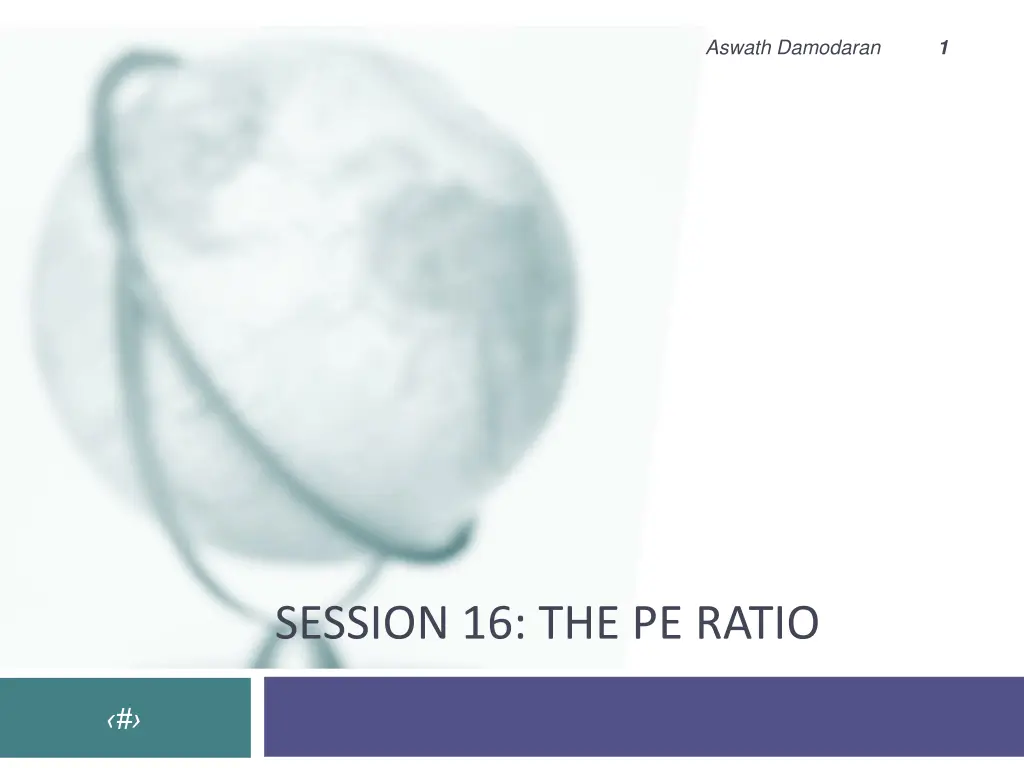
Understanding PE Ratios in Valuation Analysis
Explore the concept of PE ratios in valuation analysis, including the calculation methods, distribution patterns, and global comparisons. Learn how PE ratios are used to analyze fundamentals and compare across sectors.
Download Presentation

Please find below an Image/Link to download the presentation.
The content on the website is provided AS IS for your information and personal use only. It may not be sold, licensed, or shared on other websites without obtaining consent from the author. If you encounter any issues during the download, it is possible that the publisher has removed the file from their server.
You are allowed to download the files provided on this website for personal or commercial use, subject to the condition that they are used lawfully. All files are the property of their respective owners.
The content on the website is provided AS IS for your information and personal use only. It may not be sold, licensed, or shared on other websites without obtaining consent from the author.
E N D
Presentation Transcript
Aswath Damodaran 1 SESSION 16: THE PE RATIO #
A Pricing Game 2 Aswath Damodaran 2
PE: The Consistency Test PE = Market Price per Share / Earnings per Share There are a number of variants on the basic PE ratio in use. They are based upon how the price and the earnings are defined. Price: is usually the current price is sometimes the average price for the year EPS: earnings per share in most recent financial year earnings per share in trailing 12 months (Trailing PE) forecasted earnings per share next year (Forward PE) forecasted earnings per share in future year 3
PE: Distribution for the US PE Ratios: US companies in January 2016 700. 600. 500. 400. 300. 200. 100. 0. 0.01 To 4 4 To 8 8 To 12 12 To 16 16 To 20 20 To 24 24 To 28 28 To 32 32 To 36 36 To 40 40 To 50 50 To 75 75 To 100 100 and over Current Trailing Forward Aswath Damodaran 4 4
With key statistics Current PE 7480 3,344. 59.42 18.53 0.11 32,269.00 777.02 13.44 37.27 11.88 30.25 Trailing PE 7480 3,223. 46.04 18.29 0.28 6,900.00 256.06 4.51 19.9 12.32 29.52 Forward PE 7480 2,647. 29.63 16.98 0.15 2,748.00 81.27 1.58 18.74 13.1 24.28 Number of firms Number with PE Average Median Minimum Maximum Standard deviation Standard error Skewness 25th percentile 75th percentile US firms in January 2016 Aswath Damodaran 5 5
Comparing Global PEs Trailing PE Ratios by Region 25.00% Average 46.04 57.57 29.83 91.08 67.42 71.16 25th perc. 12.32 10.27 9.96 9.57 8.87 10.00 Median 18.29 16.69 15.08 16.77 15.69 16.69 75th perc. 29.52 26.76 24.93 39.69 27.52 32.07 United States Europe Japan Emerging Markets Aus, NZ & Canada Global <4 20.00% 4 To 8 8 To 12 12 To 16 16 To 20 15.00% 20 To 24 24 To 28 28 To 32 10.00% 32 To 36 36 To 40 40 To 50 50 To 75 5.00% 75 To 100 100 and over 0.00% US Europe Japan Emerging Markets Aus, NZ & Canada Global Aswath Damodaran 6 6
PE Ratio: The Analytics To understand the fundamentals, start with a basic equity discounted cash flow model. With the dividend discount model, P0=DPS1 r -gn Dividing both sides by the current earnings per share, P0 EPS0 = PE= Payout Ratio *(1+gn) r-gn If this had been a FCFE Model, P0=FCFE1 r -gn =PE = (FCFE/Earnings)*(1+gn) P0 EPS0 r-gn 7
PE, Growth and Risk Dependent variable is: PE R squared = 66.2% R squared (adjusted) = 63.1% Variable Coefficient Constant 13.1151 Growth rate 121.223 Emerging Market -13.8531 Emerging Market is a dummy: 1 if emerging market SE 3.471 3.78 0.0010 19.27 6.29 0.0001 3.606 -3.84 0.0009 t-ratio prob 0 if not 9
Is Telebras under valued? Predicted PE = 13.12 + 121.22 (.075) - 13.85 (1) = 8.35 At an actual price to earnings ratio of 8.9, Telebras is slightly overvalued. 10
PE Ratio versus the market PE versus Expected EPS Growth: January 2016 Aswath Damodaran 11 11
PE Ratio: Standard Regression for US stocks - January 2016 The regression is run with growth and payout entered as decimals, i.e., 25% is entered as 0.25) Aswath Damodaran 12 12
PE ratio regressions across markets January 2016 R2 Region Regression January 2016 US PE = 8.76 + 75.24 gEPS + 19.73 Payout 4.08 Beta 40.5% Europe PE = 13.43 + 54.46 gEPS + 17.63 Payout - 4.16 Beta 24.7% Japan PE = 20.10+ 26.46 gEPS + 24.87 Payout 7.60 Beta 28.4% Emerging Markets PE = 15.13 + 40.99 gEPS + 9.03 Payout - 2.14 Beta 11.5% Australia, NZ, Canada PE = 7.31 + 73.42 gEPS + 13.94 Payout 3.73 Beta 26.8% Global PE = 12.51 + 87.48 gEPS + 11.48 Payout - 3.96 Beta 27.5% gEPS=Expected Growth: Expected growth in EPS or Net Income: Next 5 years Beta: Regression or Bottom up Beta Payout ratio: Dividends/ Net income from most recent year. Set to zero, if net income < 0 Aswath Damodaran 13 13
